- NLI Research Institute >
- Over 60% of Companies Favor Deregulation Amid Growing Concern Over Economic Prospects - Nissay Business Climate Survey -
Over 60% of Companies Favor Deregulation Amid Growing Concern Over Economic Prospects - Nissay Business Climate Survey -
the Industrial Research Dept.
Font size
- S
- M
- L
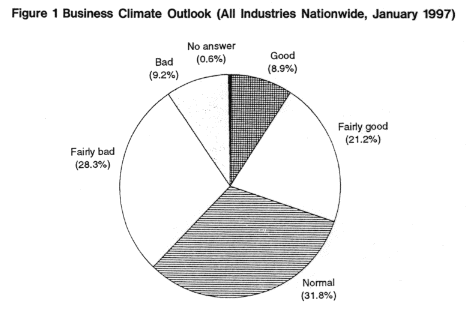
1. Economic Trends
(1) Despite Expectations of a Continued Moderate Recovery,
Concern Mounts Over the Economy's Prospects
The all-industry business climate DI (diffusion index, which measures the proportion of companies reporting favorable versus unfavorable prospects; see Figure 2) improved slightly to -3.9 from -5.6 in the previous survey (September 1996).
However, differences remain large between industries (Table 1). The DI deteriorated for transport & warehousing (-23.6) and construction & capital equipment (-16.4), while improving for services (8.5) and processing manufacturing (1.0). There were no noticeable trends by company size.
The all-industry DI for the outlook to the end of September 1997 (-12.3) is significantly worse than for the present as a result of stronger caution regarding future prospects based on fluctuations in stock, foreign exchange, and other financial markets at the time of the survey.
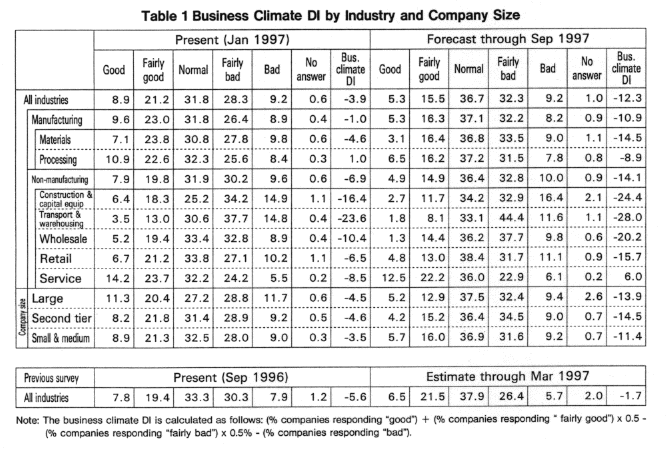
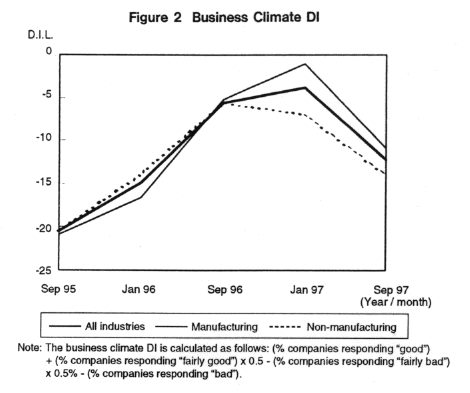
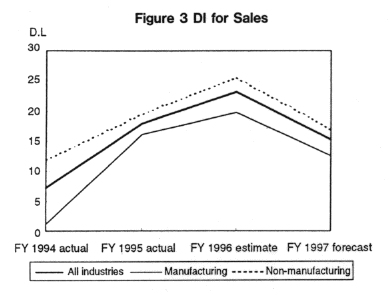
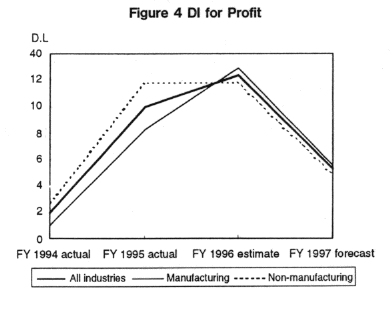
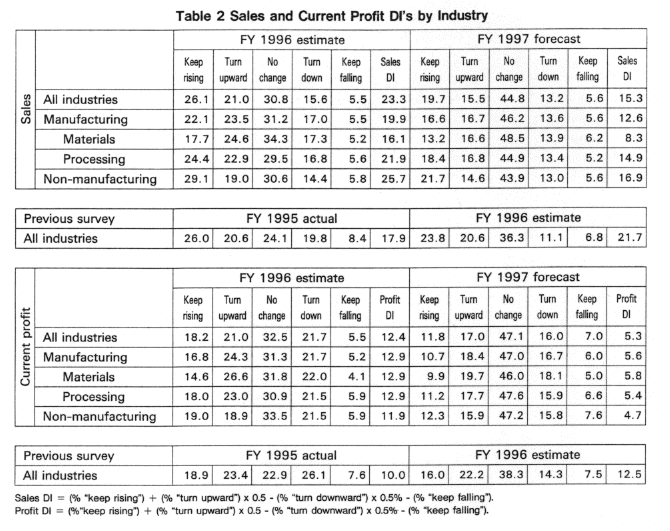
(2) Sales and Current Profits are Recovering Overall,
Particularly in Services and Retail
The all-industry sales DI (higher sales versus lower sales; see Table 2) edged upward for the FY 1996 estimate to 23.3 from the previous forecast (21.7). By sector, services (34.0) and retail (32.3) expect higher sales, while transport & warehousing (2.8) showed only slight improvement. As for the outlook for FY 1997, the all-industry DI of 15.3 shows that more companies expect to see continued sales growth.
With regard to current profit, the all-industry profit DI (higher profits versus lower profits; see Table 2) was almost unchanged at 12.4 for FY 1996 from the previous survey (12.5), suggesting a moderate recovery trend. By sector, the pattern is similar to sales, with services (17.1) and retail sales (15.0) expecting higher profits, and transport & warehousing (-0.9) slow to improve. For the FY 1997 outlook, the all-industry DI of 5.3 indicates that while the sense that profits have recovered is less pronounced than for FY 1996, more companies expect profit increases than declines.
(3) Brighter Outlook in Kanto, Koshinetsu, and Hokuriku Regions
Looking at the present business climate DI's by region, the Kanto, Koshinetsu, and Hokuriku regions are above the national average, while Kyushu, Hokkaido, and Kinki are below. In addition, the same pattern can be seen regarding the outlook to September 1997.
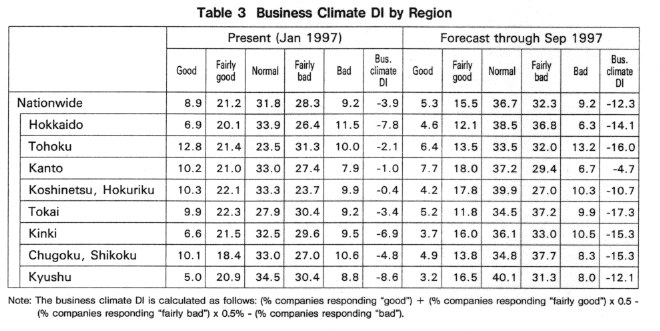
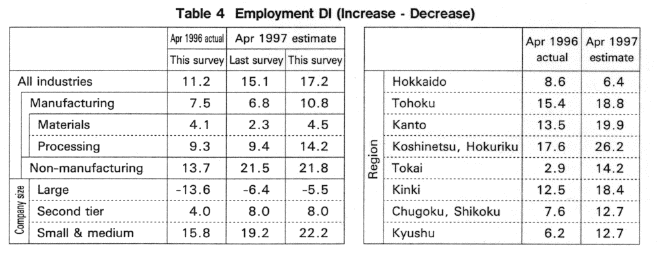
(4) Employment Environment Recovers Centered Around Small and Mid-sized Companies and the Non-Manufacturing Sector
The employment environment appears to be improving, with the DI for estimated change in number of employees as of April 1997 (intention to increase vs. decrease; Table 4) at 17.2 for all industries nationwide, above 15.1 in the previous survey. By company size, hiring intentions are strong among small and mid-sized companies, while many large companies still intend to reduce employment. The most aggressive industries are services and construction & capital equipment in the non-manufacturing sector, while basic materials industries remain stagnant.
By region, many companies in the Koshinetsu, Hokuriku, and Kanto regions intend to increase employment, while companies in Hokkaido are lackluster relative to other regions.
(5) Investment Intentions Edge Downward
The proportion of companies expecting to make capital investments in fiscal 1996 was 58.3% (all industries, nationwide), down from the previous survey (64.4%). Despite the high proportions in processing (71.1%) and materials (69.8%) in the manufacturing sector and transport & warehousing (66.9%), all industries were lower than in the previous survey. For fiscal 1997, 59.5% of all industries nationwide have investment plans.
(6) Continued Low Interest Rates Expected Amid Stagnant Financial Markets
More companies expect interest rates to remain level. The interest rate prediction DI through September 1997 (increase versus decrease; Figure 5) was 16.9, substantially below 51.2 from the previous survey.
Regarding predictions for the exchange rate and stock prices through September 1997, the yen was expected to strengthen slightly against the dollar to ¥115.62 (all industries nationwide), and the Nikkei average was expected to edge up to ¥19,212. The weak yen and soft stock prices at the time of the survey are believed to have strongly influenced expectations.
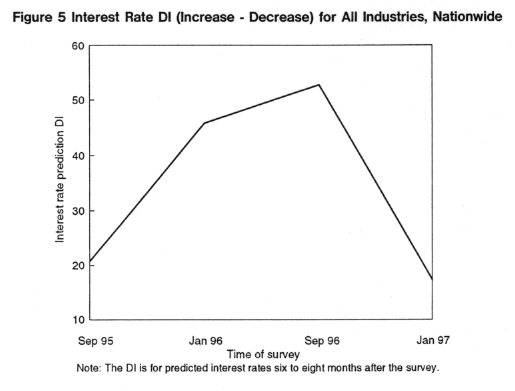
(7) 16% of Companies Consider Listing Stock
While 7.3% (378 companies) were considering listing their stock, if the companies responding that they planned to list their stock sometime in the future are added, the proportion rises to 16.1% (832 companies). By industry, the proportion of companies in the service industry was high at 12.7%. Although many companies considering listing were undecided as to the timing of their listing, one-third (34.7%) responded that they planned to list in the next three years (1999).
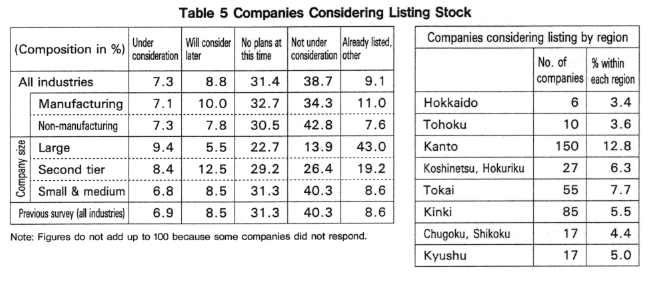
2. Deregulation and Corporate Management
The survey asked companies their perspective on deregulation, a much discussed issue as of late.
(1) Over 60% Seek Deregulation
Asked whether they seek deregulation in their own business area, 61.9% of companies in all industries responded affirmatively to either wide-ranging or partial deregulation. Thus most companies favor some form of deregulation (Table 6).
By industry, the non-manufacturing sector was more keen on deregulation than the manufacturing sector. Specifically, positive responses were highest in construction & capital equipment (70.3%) and retail (69.2%), and low for processing (57.3%). On the other hand, 12.0% of companies in transport & warehousing responded that deregulation is needed in their businesses. Moreover, the demand for deregulation increased with company size, with 77.3% of large companies seeking deregulation. This suggests that the larger the company is, the greater the expectation of advantages from deregulation.
By region, the proportion of companies seeking deregulation was noticeably high in Kyushu and low in Kinki. In addition, the proportion of companies seeking wide-ranging deregulation was highest in the Kanto region at 30.0%, and lowest in the Kinki region at 22.6%.
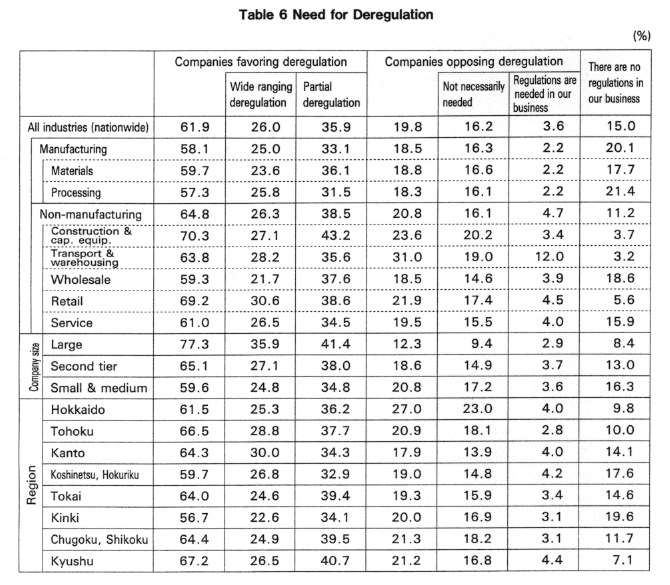
(2) Expanded Business Opportunities and Reduction of Filings Cited as Advantages
The most commonly cited advantages of deregulation were expanded business opportunities in both current and new business areas (48.3%) and reduction of documents to be filed (34.5%), followed by cost reduction (22.1%; Table 7).
By industry, the most common response in the service industry was expanded business opportunities at 64.0%, while transport & warehousing, construction & capital equipment, and retail industries cited reduced filing requirements more frequently than other industries. Overall, many companies in the non-manufacturing sector cited expanded business opportunities, while many manufacturers cited cost reduction.
By company size, the proportion of companies citing expanded business opportunities, reduced filing requirements, and cost reduction rose with company size.
By region, the proportion of companies citing expanded opportunities in current and new business areas was noticeably higher in the Kanto region. The proportion of companies citing reduced filing requirements was high in the Chugoku/Shikoku and Kyushu regions.
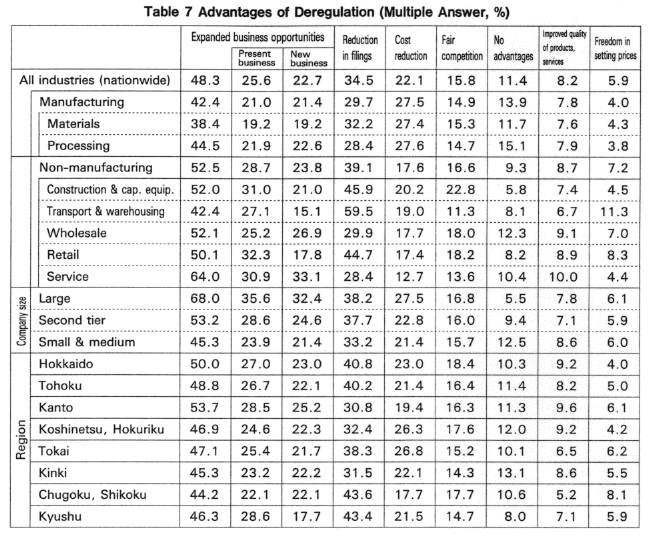
(3) Increased Price Competition Cited as the Greatest Disadvantage of Deregulation
The most commonly cited disadvantage of deregulation was increased price competition at 43.0%, followed by disruption of the status quo at 19.7%. On the other hand, 21.4% of companies saw no disadvantages.
The proportion of companies citing increased price competition was highest in transport & warehousing (64.8%) and retail industries (54.9%). Disruption of the status quo was most cited by transport & warehousing (39.8%) and construction & capital equipment (30.5%). On the other hand, almost 30% of processing manufacturers and services saw no disadvantages. In addition, the proportion of companies citing increased price competition rose with company size.
(4) Deregulation Should Target Reduced Filings and Employment and Labor
Asked what areas deregulation should be pursued in, the most common response was in the reduction of filing requirements at 37.6%, followed by employment and labor regulations at 25.0% (Table 9).
By industry, reduced filing requirements was cited most frequently by the non-manufacturing sector, while the manufacturing sector cited employment and labor regulations. A noticeably strong response on reducing filing requirements was seen in the transportation and warehousing, retail, and construction and facility construction industries.
By company size, the larger the company, the higher the inclination was toward easing employment and labor regulations. By region, Chugoku /Shikoku cited reduced filings most frequently at 48.6%, while the Kanto region was lowest at 32.7%. In addition, Hokkaido had a high proportion of companies seeking deregulation on the use of construction and real estate.
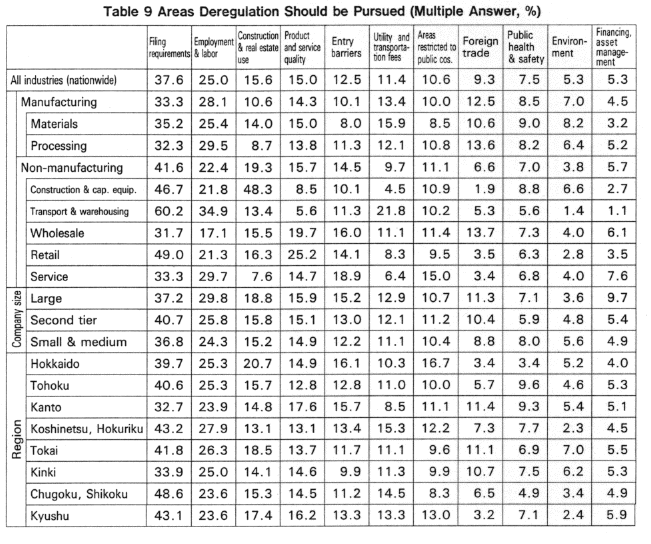
Appendix: Outline of the Nissay Business Climate Survey
The present Nissay Business Climate Survey is the fourth semi-annual survey conducted each October and March since fiscal 1996. The survey sample consists primarily of companies in Nippon Life Insurance Company's client base, and the results are collected and analyzed by NLI Research Institute.
- Survey period: Mid December 1996 to January 1997
- Number of companies responding: 5,182
- Company size, location, and industry: See tables below
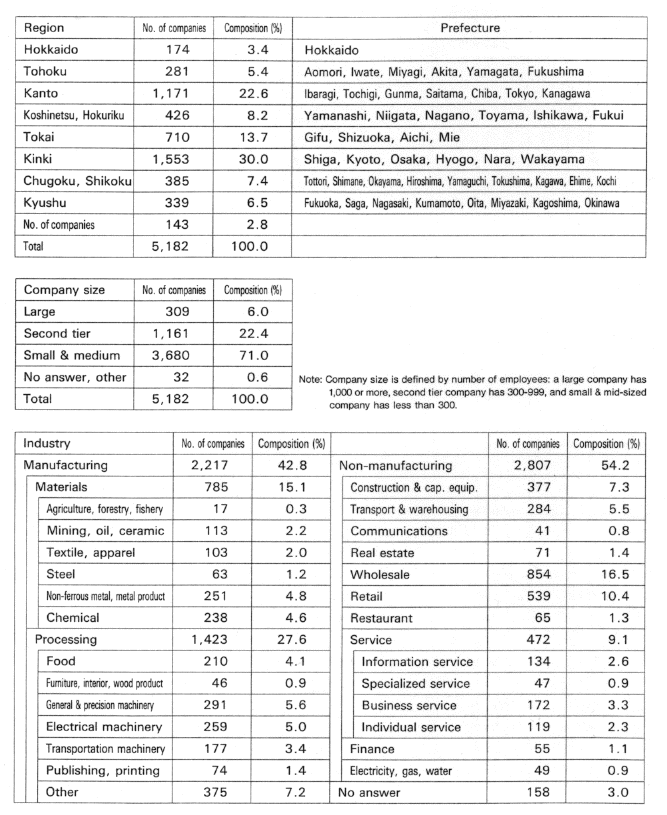
the Industrial Research Dept.
Research field
レポート紹介
-
研究領域
-
経済
-
金融・為替
-
資産運用・資産形成
-
年金
-
社会保障制度
-
保険
-
不動産
-
経営・ビジネス
-
暮らし
-
ジェロントロジー(高齢社会総合研究)
-
医療・介護・健康・ヘルスケア
-
政策提言
-
-
注目テーマ・キーワード
-
統計・指標・重要イベント
-
媒体
- アクセスランキング

















